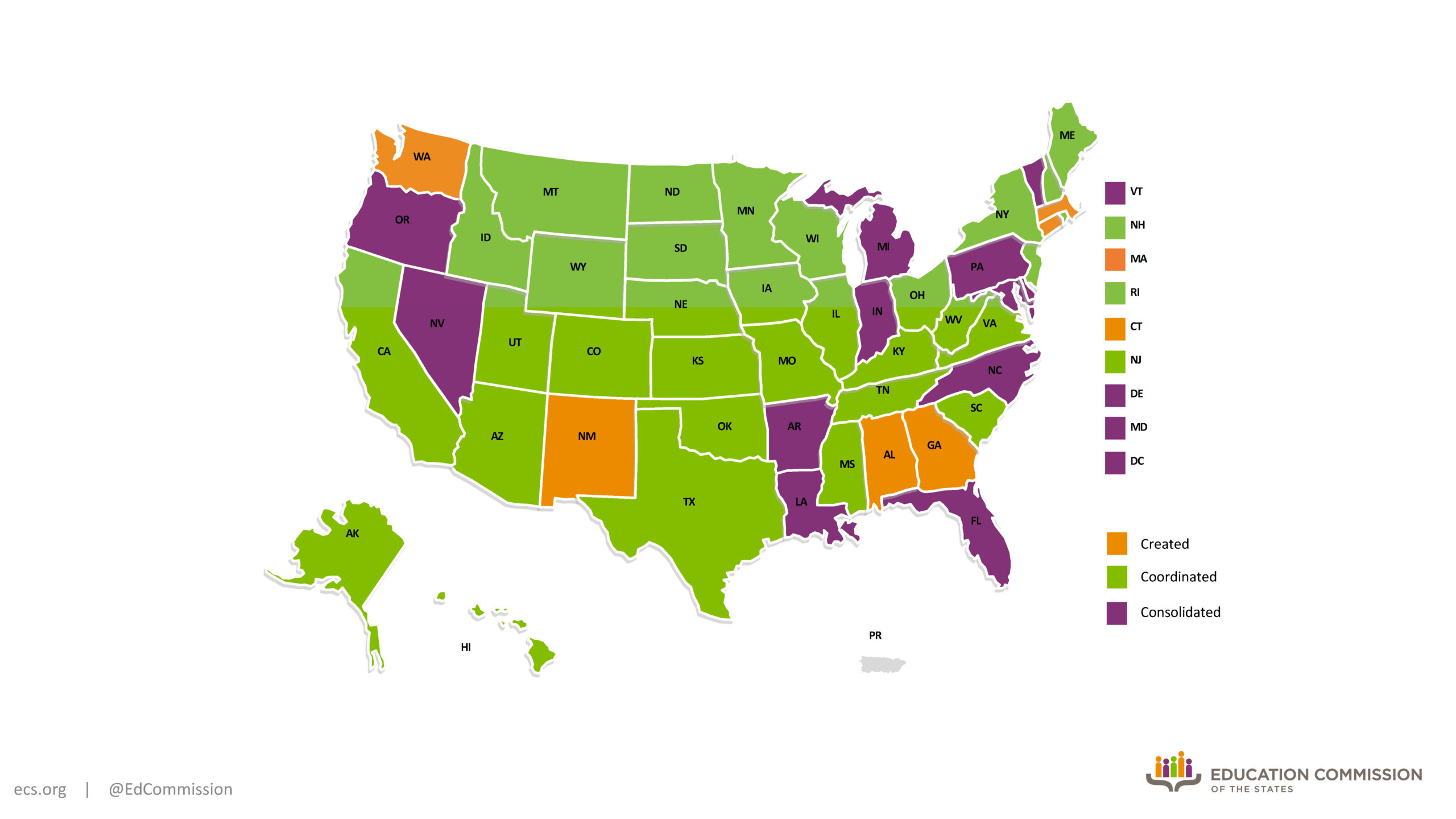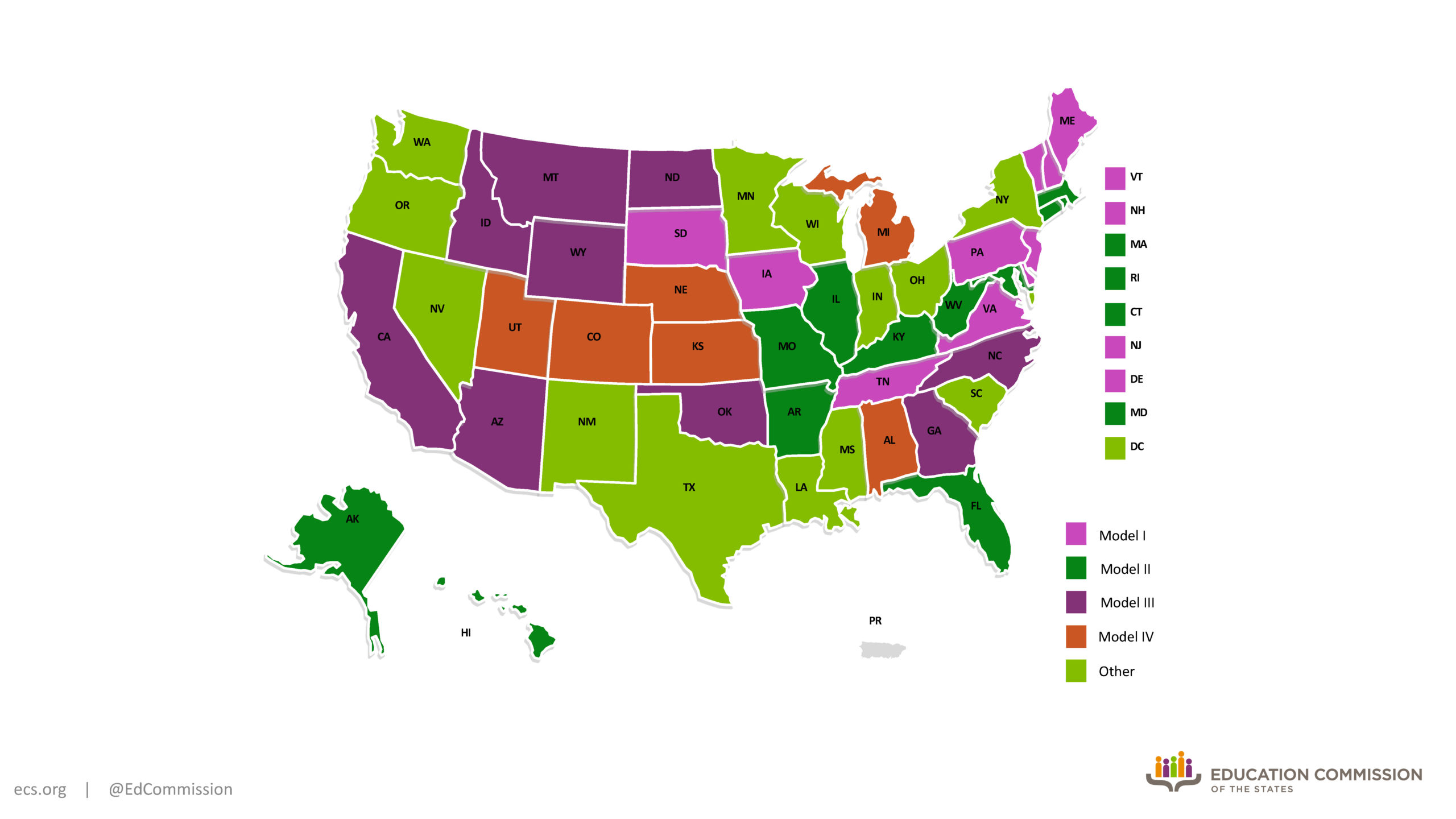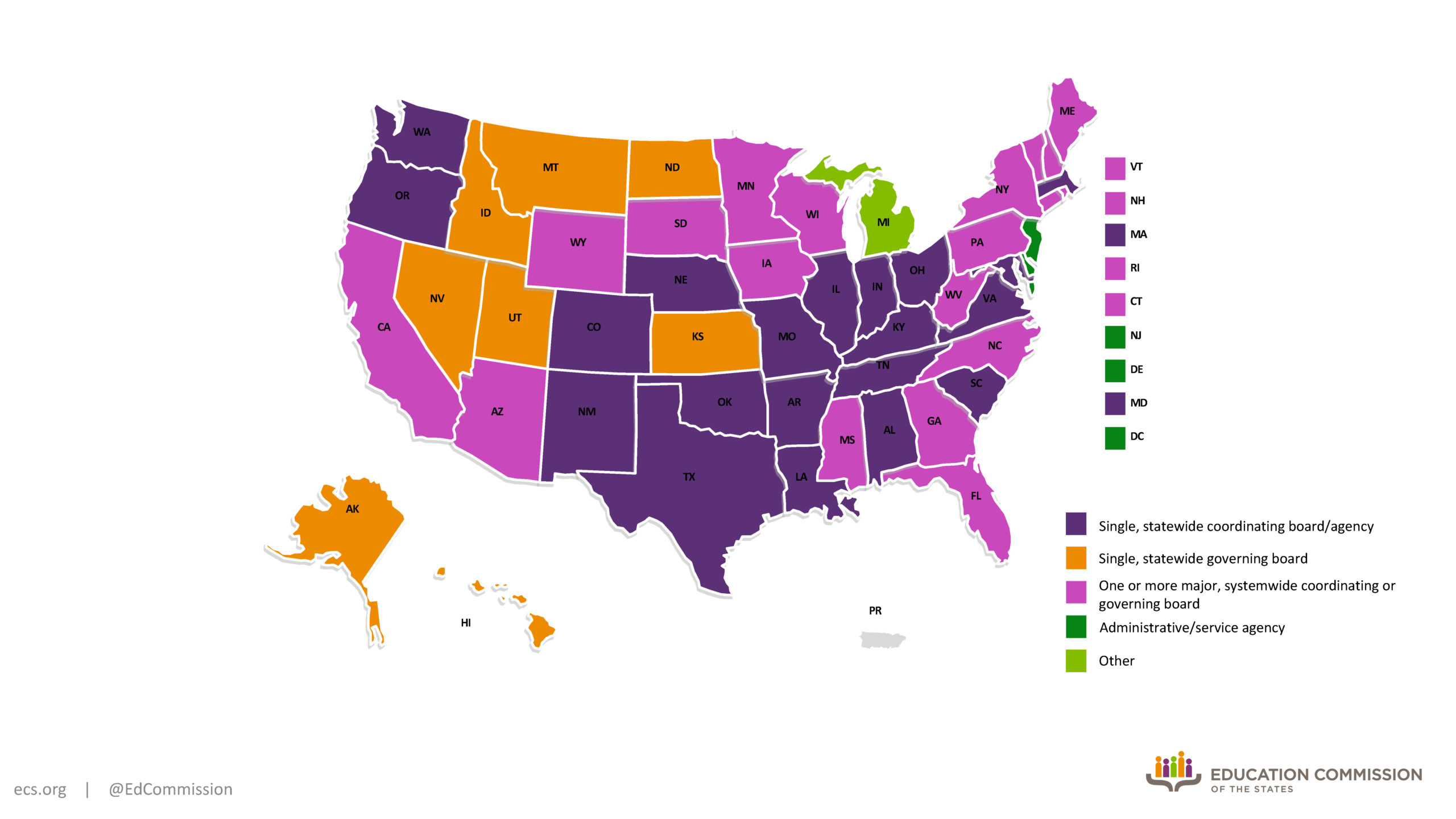| State |
Early Care and Education Governance |
K-12 Governance |
Postsecondary Governance |
| Alabama |
Created |
Model IV: Elected Board, Board Appoints Chief |
Single, statewide coordinating board/agency |
| Alaska |
Coordinated |
Model II: Governor Appoints Board, Board Appoints Chief |
Single, statewide governing board |
| Arizona |
Coordinated |
Model III: Governor-Appointed Board, Elected Chief |
One or more major, systemwide coordinating or governing board and Administrative/service agency |
| Arkansas |
Consolidated |
Model II: Governor Appoints Board, Board Appoints Chief |
Single, statewide coordinating board/agency |
| California |
Coordinated |
Model III: Governor-Appointed Board, Elected Chief |
One or more major, systemwide coordinating or governing board |
| Colorado |
Coordinated |
Model IV: Elected Board, Board Appoints Chief |
Single, statewide coordinating board/agency |
| Connecticut |
Created |
Model II: Governor Appoints Board, Board Appoints Chief |
One or more major, systemwide coordinating or governing board and Administrative/service agency |
| Delaware |
Consolidated |
Model I: Governor-Appointed Board, Governor-Appointed Chief |
Administrative/service agency |
| District of Columbia |
Consolidated |
Other: Elected Board; Mayor-Appointed Chief |
Administrative/service agency |
| Florida |
Consolidated |
Model II: Governor Appoints Board, Board Appoints Chief |
One or more major, systemwide coordinating or governing board and Administrative/service agency |
| Georgia |
Created |
Model III: Governor-Appointed Board, Elected Chief |
One or more major, systemwide coordinating or governing board |
| Hawaii |
Coordinated |
Model II: Governor Appoints Board, Board Appoints Chief |
Single, statewide governing board |
| Idaho |
Coordinated |
Model III: Governor-Appointed Board, Elected Chief |
Single, statewide governing board |
| Illinois |
Coordinated |
Model II: Governor Appoints Board, Board Appoints Chief |
Single, statewide coordinating board/agency |
| Indiana |
Consolidated |
Other: Jointly appointed Board, Governor-Appointed Chief |
Single, statewide coordinating board/agency |
| Iowa |
Coordinated |
Model I: Governor-Appointed Board, Governor-Appointed Chief |
One or more major, systemwide coordinating or governing board and Administrative/service agency |
| Kansas |
Coordinated |
Model IV: Elected Board, Board Appoints Chief |
Single, statewide governing board |
| Kentucky |
Coordinated |
Model II: Governor Appoints Board, Board Appoints Chief |
Single, statewide coordinating board/agency |
| Louisiana |
Consolidated |
Other: Governor-Appointed and Elected State Board; Board-Appointed Chief |
Single, statewide coordinating board/agency |
| Maine |
Coordinated |
Model I: Governor-Appointed Board, Governor-Appointed Chief |
One or more major, systemwide coordinating or governing board |
| Maryland |
Consolidated |
Model II: Governor Appoints Board, Board Appoints Chief |
Single, statewide coordinating board/agency |
| Massachusetts |
Created |
Model II: Governor Appoints Board, Board Appoints Chief |
Single, statewide coordinating board/agency |
| Michigan |
Consolidated |
Model IV: Elected Board, Board Appoints Chief |
Not applicable. Michigan does not have a statewide postsecondary board or agency or a major, systemwide board, and therefore does not fall under any of the governance models. |
| Minnesota |
Coordinated |
Other: No State Board; Governor-Appointed Chief |
One or more major, systemwide coordinating or governing board and Administrative/service agency |
| Mississippi |
Coordinated |
Other: Jointly Appointed State Board; Board-Appointed Chief |
One or more major, systemwide coordinating or governing board |
| Missouri |
Coordinated |
Model II: Governor Appoints Board, Board Appoints Chief |
Single, statewide coordinating board/agency |
| Montana |
Coordinated |
Model III: Governor-Appointed Board, Elected Chief |
Single, statewide governing board |
| Nebraska |
Coordinated |
Model IV: Elected Board, Board Appoints Chief |
Single, statewide coordinating board/agency |
| Nevada |
Consolidated |
Other: Governor-Appointed and Elected State Board; Governor-Appointed Chief |
Single, statewide governing board |
| New Hampshire |
Coordinated |
Model I: Governor-Appointed Board, Governor-Appointed Chief |
One or more major, systemwide coordinating or governing board and Administrative/service agency |
| New Jersey |
Coordinated |
Model I: Governor-Appointed Board, Governor-Appointed Chief |
Administrative/service agency |
| New Mexico |
Created |
Other: Advisory Only; Governor-Appointed Chief |
Single, statewide coordinating board/agency |
| New York |
Coordinated |
Other: Legislatively Appointed State Board; Board-Appointed Chief |
One or more major, systemwide coordinating or governing board and Administrative/service agency |
| North Carolina |
Consolidated |
Model III: Governor-Appointed Board, Elected Chief |
One or more major, systemwide coordinating or governing board |
| North Dakota |
Coordinated |
Model III: Governor-Appointed Board, Elected Chief |
Single, statewide governing board |
| Ohio |
Coordinated |
Other: Governor-Appointed and Elected State Board; Board-Appointed Chief |
Single, statewide coordinating board/agency |
| Oklahoma |
Coordinated |
Model III: Governor-Appointed Board, Elected Chief |
Single, statewide coordinating board/agency |
| Oregon |
Consolidated |
Other: Governor-Appointed State Board, Governor as Chief |
Single, statewide coordinating board/agency |
| Pennsylvania |
Consolidated |
Model I: Governor-Appointed Board, Governor-Appointed Chief |
One or more major, systemwide coordinating or governing board and Administrative/service agency |
| Rhode Island |
Coordinated |
Model II: Governor Appoints Board, Board Appoints Chief |
One or more major, systemwide coordinating or governing board |
| South Carolina |
Coordinated |
Other: Legislatively Appointed State Board; Elected Chief |
Single, statewide coordinating board/agency |
| South Dakota |
Coordinated |
Model I: Governor-Appointed Board, Governor-Appointed Chief |
One or more major, systemwide coordinating or governing board |
| Tennessee |
Coordinated |
Model I: Governor-Appointed Board, Governor-Appointed Chief |
Single, statewide coordinating board/agency |
| Texas |
Coordinated |
Other: Elected Board; Governor-Appointed Chief |
Single, statewide coordinating board/agency |
| Utah |
Coordinated |
Model IV: Elected Board, Board Appoints Chief |
Single, statewide governing board |
| Vermont |
Consolidated |
Model I: Governor-Appointed Board, Governor-Appointed Chief |
One or more major, systemwide coordinating or governing board |
| Virginia |
Coordinated |
Model I: Governor-Appointed Board, Governor-Appointed Chief |
Single, statewide coordinating board/agency |
| Washington |
Created |
Other: Governor-Appointed and Elected State Board; Elected Chief |
Single, statewide coordinating board/agency |
| West Virginia |
Coordinated |
Model II: Governor Appoints Board, Board Appoints Chief |
One or more major, systemwide coordinating or governing board |
| Wisconsin |
Coordinated |
Other: No State Board; Elected Chief |
One or more major, systemwide coordinating or governing board |
| Wyoming |
Coordinated |
Model III: Governor-Appointed Board, Elected Chief |
One or more major, systemwide coordinating or governing board |





